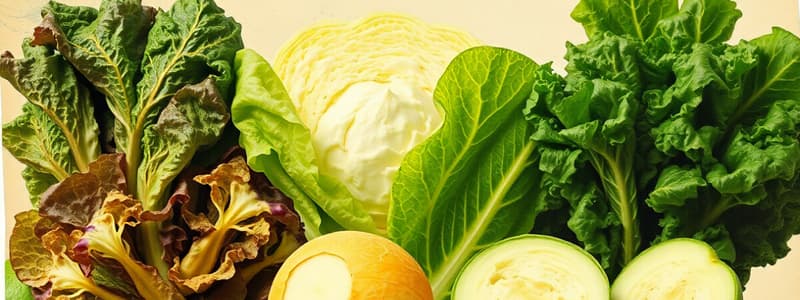Podcast
Questions and Answers
The ideal storage temperature for lettuce is between 30-32°F (-1 to 0°C).
The ideal storage temperature for lettuce is between 30-32°F (-1 to 0°C).
False (B)
Leaf lettuce generally has a longer shelf life compared to head lettuce like iceberg or romaine.
Leaf lettuce generally has a longer shelf life compared to head lettuce like iceberg or romaine.
False (B)
Prices for lettuce tend to be lower during the summer and fall months.
Prices for lettuce tend to be lower during the summer and fall months.
False (B)
The United States' primary lettuce-growing regions are located in California and Arizona.
The United States' primary lettuce-growing regions are located in California and Arizona.
Transportation costs have no effect on lettuce prices during off-seasons.
Transportation costs have no effect on lettuce prices during off-seasons.
Crispness and vibrant color are quality indicators for assessing lettuce.
Crispness and vibrant color are quality indicators for assessing lettuce.
Wholesalers might import lettuce from countries like Canada when local supply runs low.
Wholesalers might import lettuce from countries like Canada when local supply runs low.
Lettuce prices stabilize when there are disruptions in major growing regions.
Lettuce prices stabilize when there are disruptions in major growing regions.
Iceberg lettuce should be stored at temperatures below 32°F to maintain freshness.
Iceberg lettuce should be stored at temperatures below 32°F to maintain freshness.
Butterhead lettuce has a shelf life of about two weeks when stored properly.
Butterhead lettuce has a shelf life of about two weeks when stored properly.
Romaine lettuce is typically harvested in the spring and summer months.
Romaine lettuce is typically harvested in the spring and summer months.
Prices of loose-leaf lettuce fluctuate significantly throughout the year due to seasonal supply variations.
Prices of loose-leaf lettuce fluctuate significantly throughout the year due to seasonal supply variations.
When assessing lettuce quality, vibrant colors and firm leaves are indicators of freshness.
When assessing lettuce quality, vibrant colors and firm leaves are indicators of freshness.
Frisee lettuce can be stored at room temperature for several days without losing quality.
Frisee lettuce can be stored at room temperature for several days without losing quality.
Mache lettuce is available year-round due to its hardy nature.
Mache lettuce is available year-round due to its hardy nature.
Batavia lettuce is known for its crunchy texture and is best used immediately after purchase.
Batavia lettuce is known for its crunchy texture and is best used immediately after purchase.
The ideal storage temperature for lettuce is 34-36°F (1-2°C).
The ideal storage temperature for lettuce is 34-36°F (1-2°C).
Fresh, properly stored lettuce typically lasts between 7-10 days.
Fresh, properly stored lettuce typically lasts between 7-10 days.
Iceberg and Romaine lettuce usually have a shorter shelf life compared to Leaf lettuce.
Iceberg and Romaine lettuce usually have a shorter shelf life compared to Leaf lettuce.
Lettuce prices are generally lower during summer and fall.
Lettuce prices are generally lower during summer and fall.
Fresh lettuce should have vibrant leaves and a neutral smell.
Fresh lettuce should have vibrant leaves and a neutral smell.
When assessing lettuce quality, limp leaves are a sign of freshness.
When assessing lettuce quality, limp leaves are a sign of freshness.
Fresh lettuce can be stored below 32°F (0°C) without risking damage.
Fresh lettuce can be stored below 32°F (0°C) without risking damage.
Transportation of lettuce should maintain a temperature above 40°F (4°C).
Transportation of lettuce should maintain a temperature above 40°F (4°C).
Flashcards
Lettuce Price Fluctuations
Lettuce Price Fluctuations
Lettuce prices change based on factors like season, supply, and transportation costs.
Winter/Early Spring Lettuce Prices
Winter/Early Spring Lettuce Prices
Lettuce prices are usually lower in winter and early spring due to stable supply or peak harvest in warm climates.
Lettuce Supply Disruptions
Lettuce Supply Disruptions
Disruptions like weather, labor shortages, or disease outbreaks in growing areas can cause price spikes.
California/Arizona Lettuce Supply
California/Arizona Lettuce Supply
Signup and view all the flashcards
Imported Lettuce
Imported Lettuce
Signup and view all the flashcards
Lettuce Storage Temp
Lettuce Storage Temp
Signup and view all the flashcards
Lettuce Shelf Life
Lettuce Shelf Life
Signup and view all the flashcards
Quality Indicators (Lettuce)
Quality Indicators (Lettuce)
Signup and view all the flashcards
Ideal Lettuce Storage Temperature
Ideal Lettuce Storage Temperature
Signup and view all the flashcards
Lettuce Spoilage Triggers
Lettuce Spoilage Triggers
Signup and view all the flashcards
Transportation Temperature
Transportation Temperature
Signup and view all the flashcards
Assessing Lettuce Quality
Assessing Lettuce Quality
Signup and view all the flashcards
Lettuce Crispness
Lettuce Crispness
Signup and view all the flashcards
Red Chicory Uses
Red Chicory Uses
Signup and view all the flashcards
Arugula Flavor & Appearance
Arugula Flavor & Appearance
Signup and view all the flashcards
Iceberg Lettuce
Iceberg Lettuce
Signup and view all the flashcards
Romaine Lettuce
Romaine Lettuce
Signup and view all the flashcards
Romaine Heart Lettuce
Romaine Heart Lettuce
Signup and view all the flashcards
Mesculin Mix Lettuce
Mesculin Mix Lettuce
Signup and view all the flashcards
Butterhead Lettuce
Butterhead Lettuce
Signup and view all the flashcards
Boston Lettuce
Boston Lettuce
Signup and view all the flashcards
Loose-Leaf Lettuce
Loose-Leaf Lettuce
Signup and view all the flashcards
Batavia Lettuce
Batavia Lettuce
Signup and view all the flashcards
Study Notes
Iceberg Lettuce
- Has curved, overlapping leaves
- Known for its mild flavor and firm, crunchy texture
- Other names: Head lettuce, Crisphead lettuce
- Uses: Shredded in salads, on sandwiches, and garnished in snacks
Romaine Lettuce
- Has long, dark green leaves
- Has a slightly bitter flavor and a crunchy texture
- The center leaves are smaller, more yellow, and sweeter
- The center leaves have a delicious flavor and texture
- Other names for Romaine Heart include Cos Lettuce
- Uses: Shredded in salads, on sandwiches, garnished in snacks, and added to Caesar or Greek salads, and sandwiches
Mesclun Mix Lettuce
- Composed of baby lettuce leaves and other greens (often herbs)
- Comes in a wide range of leaf shapes, colors, textures, and tastes
- Uses: In salads, side dishes, smoothies, and as a garnish
Butterhead Lettuce
- Has soft, buttery-textured leaves
- Forms small, loosely-folded heads
- Has a sweet, delicious flavor
- Other names include Buttercrunch lettuce
- Uses: In salads and wraps
Boston Lettuce
- A type of butterhead lettuce
- Contains soft, supple, and pale green leaves
- Forms small, round, and loosely-bound heads
- Use: excellent cups for ground shrimp or ground chicken
Loose-Leaf Lettuce
- Contains large, moderately crispy, loosely-packed leaves
- Does not form compact heads
- Has a mild, sweet flavor
- Other names: Leaf lettuce
- Use: mixed with other vegetables or cooked meat, shredded in tacos, added to sandwiches
Batavia Lettuce
- Consists of red-tinted or green leaves
- Leaves are crunchy and have a nutty flavor
- Other Names: Summer crisp, French crisp
- Uses: As a topping with balsamic vinegar or honey mustard vinaigrette
Frisee Lettuce
- Comes with curly, frizzled green leaves tinged with yellow
- Has a slightly bitter flavor and a crunchy texture
- Other names include Curly chicory, curly endive, chicory endive
- Uses: As a base for French bistro salad, also included in pear salad with walnuts and blue cheese
Mache Lettuce
- Has small, delicate leaves
- Imparts a slightly mild, sweet flavor to salads
- Other names include Lambs' lettuce, field lettuce, fetticus
- Use: Mixes well with shallot vinaigrette
Bibb Lettuce
- Smaller than Boston lettuce
- Bibb’s head is equivalent to the size of one’s fist
- Twice as expensive as iceberg lettuce
- Uses: Works well as a salad green and a wrapper
Cress Lettuce
- Has small green leaves and sturdy, fibrous stems
- Imparts a peppery taste to food
- Other names include Watercress, curly cress, land cress, upland cress
- Uses: For salad dressing with mustard vinaigrette
Mizuna Lettuce
- Characterized by spiky, green leaves
- Has a delicate texture and spicy, peppery flavor
- Sold loose or a pre-made mix
- Other names include Spider mustard, Japanese greens, California peppergrass, potherb mustard
- Use: sprinkled with sesame seed dressing, light vinaigrette, or added to Japanese mocha soup
Oak Leaf Lettuce
- Has a loose-leaf arrangement
- Comes in different colors including green, bronze, and red
- Other names include Leaf lettuce
- Uses: Makes excellent salads, can be served with a variety of dressings
Little Gem Lettuce
- Has soft leaves that add a bit of crunchiness and a delicate flavor to salads and dressings
- Uses: Sprinkle with lemony dressings and ginger vinaigrette
Batavia Lettuce
- Has large green leaves
- Has a crispy texture and a mildly bitter taste
- Other names include Escarole, broad-leaved endive
- Use: Popular in Italian cuisine, often paired with beans and added to soups
Radicchio Lettuce
- Has either an oval or compact round shape
- Has a sweeter taste and brown color when roasted or grilled
- Other names include Red chicory, Chioggia, red Italian chicory
- Use: Typically added to salads, pasta, and risotto, the leaves are also stewed
Arugula Herb
- Has a peppery flavor and dark green leaves
- Leaves are either shorter and rounded or longer and spiked
- Other Names include Rocket, rucola
- Uses: In tangy dressings like lemon garlic vinaigrette, for adding bold flavors in blue cheese, or mixing with other lettuces for a stronger taste
Tatsoi Cabbage
- Characterized by small, rounded leaves
- Has a baby spinach-like texture
- Other names include Spoon cabbage, rosette bok choy, spoon cabbage
- Use: Cooked in stir-fried Chinese dishes
Belgian Endive
- Characterized by tight, compact leaves
- Has a fresh, crunchy texture
- Has a slightly bitter taste
- Other names include French endive, Belgium chicory, witloof
- Use: As small appetizers, with goat cheese, walnut, apple, and orange salads
Vegetables that look like lettuce
Storage, Temperature and Shelf Life of Lettuce
- Ideal storage temperature: 34-36°F (1-2°C)
- Shelf life: Typically 5-7 days in optimal conditions, varying depending on type and harvest freshness
- Too high a temperature (above 40°F or 4°C) leads to wilting and spoilage
- Too low a temperature (below 32°F or 0°C) can cause freezing and deterioration
- Transportation: Maintain the same cool temperature range (34-36°F or 1-2°C) during transit
Assessing Lettuce Quality
- Crispness: Fresh lettuce should feel firm and crisp
- Color: Healthy leaves are vibrant green or reddish
- Leaf Condition: Avoid leaves with yellowing, browning, or slimy spots, wilting, or decay
- Smell: Fresh lettuce has a clean, neutral smell. A sour smell indicates spoilage
- Quality indicators: Look for crispness, vibrant color, and firm leaves. Avoid lettuce with yellowing, wilting, or slimy patches
Seasonality and Price Fluctuations
- When prices are high: Typically in summer and fall due to hotter weather, supply issues, and transportation costs.
- When prices are low: Typically during winter or early spring when supply is more stable or the harvest season peaks in warm regions
Supply Variations by Region
- Locals: California and Arizona are largest lettuce growing regions, with more stable supply, but weather/disease disrupt supply.
- Imports: When local supply is low/low quality, wholesalers turn to imports (Mexico), potentially changing variability in price and quality.
Studying That Suits You
Use AI to generate personalized quizzes and flashcards to suit your learning preferences.




